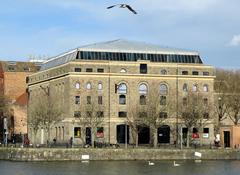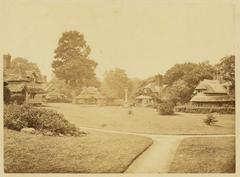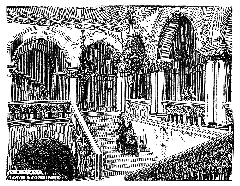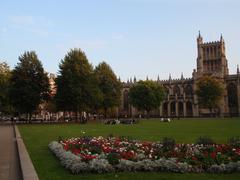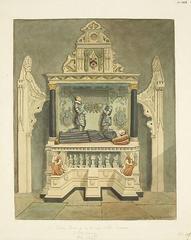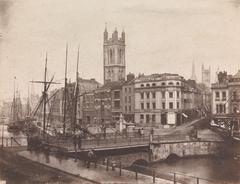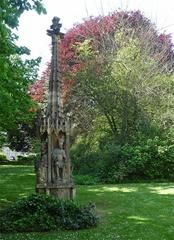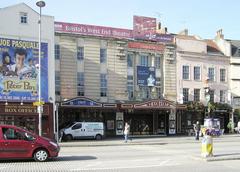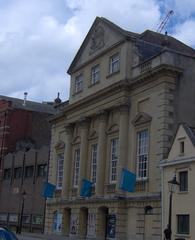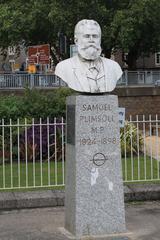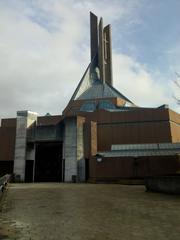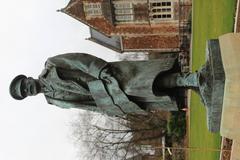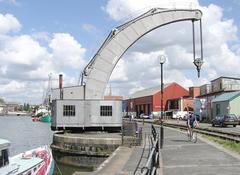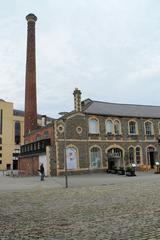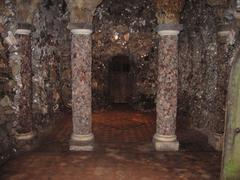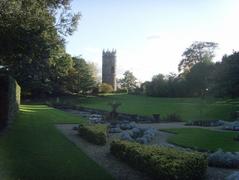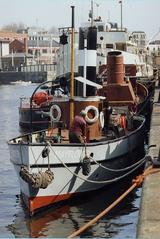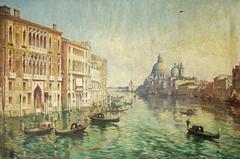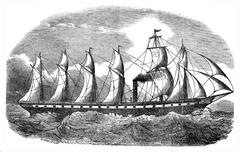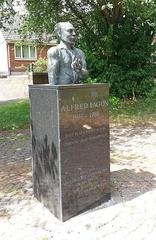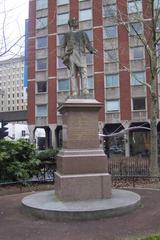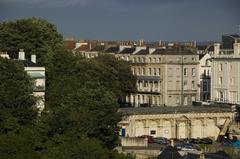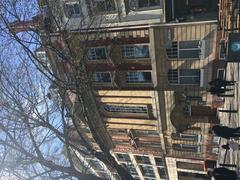
Bristol Castle: Visiting Hours, Tickets, and Historical Significance
Date: 04/07/2025
Introduction
Bristol Castle, once a mighty Norman fortress, is now immortalized in the heart of Bristol as part of Castle Park—a vibrant public space that preserves the remnants of centuries-old history. From its origins as a symbol of royal power to its role in national conflicts and its present function as a cherished green space, the castle’s story is deeply interwoven with that of the city itself. This comprehensive guide provides essential information on Bristol Castle’s history, architectural features, visiting hours, tickets, accessibility, nearby attractions, and practical tips for an enriching visitor experience. For official updates and guided tour information, consult Bristol City Council and Visit Bristol.
Historical Overview
Saxon and Norman Foundations
Bristol’s development as a strategic settlement began in the Saxon era, with Brycgstow (“the place at the bridge”) flourishing as a market town and port by the 10th century (Wikipedia: History of Bristol). After the Norman Conquest in 1066, William the Conqueror ordered the construction of a motte-and-bailey castle to secure the city—work credited to Geoffrey de Montbray (Building History: Bristol Origins). By the 12th century, timber defenses were replaced by imposing stone walls, a keep, and defensive towers, transforming Bristol Castle into one of the most formidable Norman fortresses in England (Wikipedia: Bristol Castle; CastlePedia: Bristol Castle).
Medieval Power and Political Turmoil
Bristol Castle’s prominence peaked during the tumultuous period known as The Anarchy (1135–1153), when it served as the principal stronghold of Empress Matilda and her half-brother Robert of Gloucester (Building History: Bristol Castle). The castle’s formidable defenses housed important prisoners, including King Stephen in 1141 (Archaeology Bristol Blog). Throughout the Middle Ages, the castle was a base for military campaigns, a royal residence, and a symbol of Bristol’s growing economic and political significance (CastlePedia: Bristol Castle; BBC News).
Decline and Demolition
By the 16th century, advances in warfare diminished the castle’s military value. During the English Civil War, it was refortified but ultimately captured and retaken by opposing forces (Local Histories: Bristol in the 17th Century; Bristol City Docks). To prevent future use as a rebel stronghold, Oliver Cromwell ordered its demolition in the mid-17th century, leaving only fragments that survive today (Wikipedia: Bristol Castle; BBC News).
Archaeology and Modern Legacy
The castle site continued to evolve, serving as a prison and military facility until the 19th century. It suffered damage during World War II, but archaeological excavations in the 20th century uncovered substantial remains—including vaults, earthworks, and wall fragments—now protected as scheduled monuments (BBC News; Bristol Post). Today, Castle Park offers a unique blend of history, green space, and community gathering.
Architectural Features and Surviving Remains
Although much of Bristol Castle is lost, visitors can still see:
- Vaulted Chambers and Walls: The most prominent medieval features, viewable through secure grilles in Castle Park (WorldWideWriter).
- Earthworks: The outlines of the original moat and ditches are discernible in the park’s topography.
- Interpretive Panels: Informative signage explains the castle’s original layout and significance.
The site reflects a blend of Norman and later Gothic architecture, with thick limestone walls, rounded and pointed arches, and remnants of defensive structures (Castlepedia).
Bristol Castle Visiting Hours and Tickets
- Castle Park: Open daily from dawn until dusk; free entry, no tickets required.
- Castle Vaults: Viewable at all times from the exterior; interior access only during special events or guided heritage tours.
- Guided Tours: Offered seasonally by local heritage groups and during city-wide events (e.g., Bristol Open Doors). Check Visit Bristol for schedules and booking information.
- Special Exhibitions or Events: Some may require advance tickets, available online or at visitor centers.
Accessibility and Facilities
- Accessibility: Main park paths are paved and suitable for wheelchairs and strollers; benches and ramps are provided. Some historic ruins may be uneven.
- Restrooms: Public toilets, including accessible facilities, are available nearby in the city center.
- Food and Drink: Numerous cafes, restaurants, and pubs border the park. The Vaulted Chambers Café (when open) offers a unique historic setting (Nomadic Matt).
- Wi-Fi: Free public Wi-Fi is available throughout much of central Bristol.
Getting There
- By Train: Bristol Temple Meads station is a 10–15 minute walk from Castle Park.
- By Bus: Multiple city routes stop near Broadmead and Old Market, adjacent to the park.
- By Car: City center car parks are nearby but can fill quickly at peak times.
- By Foot or Bike: Well-marked walking and cycling routes provide easy access.
Nearby Attractions
- Bristol Cathedral: Renowned medieval architecture and free guided tours (PlanetWare).
- St. Nicholas Market: Bustling indoor market with local crafts and food.
- Bristol Harbourside: Features the SS Great Britain, museums, and the Arnolfini arts centre.
- Left Handed Giant Brewpub: Modern venue for craft beer overlooking the river (Jetsetting Fools).
Visitor Tips
- Best Time to Visit: Spring and summer offer vibrant scenery and frequent events; autumn provides colorful foliage; winter is quieter.
- Family-Friendly: Open lawns and riverside paths are ideal for family outings; no formal playground, but plenty of space for informal play.
- Photography: River views, historic ruins, and city backdrops offer excellent opportunities. Drones require city council permission.
- Events: Castle Park hosts concerts, food festivals, and community gatherings year-round (Visit West).
Frequently Asked Questions (FAQs)
Q: Are tickets required to visit Bristol Castle?
A: No, entry to Castle Park and viewing the castle remains is free. Tickets may be required for special guided tours.
Q: What are the opening hours?
A: Castle Park is open daily from dawn until dusk; the Vaulted Chambers Café (when open) generally operates from 10:00 AM to 5:00 PM.
Q: Is the site accessible for wheelchairs?
A: Yes, main paths are accessible, though some historic areas have uneven surfaces.
Q: Are guided tours available?
A: Yes, especially during heritage events and peak seasons. Check Visit Bristol for current offerings.
Q: What other attractions are nearby?
A: Bristol Cathedral, St. Nicholas Market, the Harbourside, and local pubs and restaurants are within a short walk.
Summary and Visitor Recommendations
Bristol Castle’s remains offer an evocative journey through England’s medieval and civil war history. Castle Park’s free access, central location, and regular cultural events make it a must-see for locals and tourists. To enrich your visit:
- Check Visit Bristol and Bristol City Council for updates, event schedules, and accessibility details.
- Download the Audiala app for audio tours and real-time visitor tips.
- Explore nearby landmarks and enjoy Bristol’s vibrant city life alongside its rich heritage.
Sources and Further Reading
- History of Bristol, Wikipedia
- Bristol Castle, Wikipedia
- A Tale of Imprisonment in Bristol Castle, Archaeology Bristol Blog
- Bristol Castle, CastlePedia
- Bristol Castle Remains Given New Protection, Bristol Post
- Visiting Bristol Castle and Castle Park, Visit Bristol
- Best Things to Do in Bristol UK, Jetsetting Fools
- Exploring Medieval Bristol, WorldWideWriter
- Things to Do in Bristol, GoSouthWestEngland
- Visit Bristol’s Guide to What’s On and What’s New in 2025, Visit West
- Nomadic Matt’s Bristol Travel Guide
- Bristol Historical Sites and Tourism, Bristol City Council







